历史
Founding and early years
In the years prior to the American Civil War, the Methodist Episcopal Church, South was considering creating a regional university for the training of ministers located centrally for the congregations of the church. After lobbying by Nashville bishop Holland McTyeire, church leaders voted to create "Central University" in Nashville in 1872. However, lack of funds and the war-ravaged state of the South delayed the opening of the college.
The following year, McTyeire stayed at the New York City residence of Cornelius Vanderbilt, whose second wife was the cousin of McTyeire's wife. Vanderbilt was the wealthiest man in America at the time, and he was considering philanthropy because as he was at an advanced age. He was planning to establish a university on Staten Island, New York, in honor of his mother. McTyeire convinced him to donate $500,000 to endow Central University in order to "contribute to strengthening the ties which should exist between all sections of our common country."
The endowment was increased to $1 million, and would be Vanderbilt's only philanthropy. The Commodore never expressed any desire that the university be named after himself, but McTyeire and his fellow trustees rechristened the school "Vanderbilt University." Vanderbilt died in 1877 without seeing the school named after him.
In the fall of 1875, about 200 students enrolled at Vanderbilt, and in October the university was dedicated. Bishop McTyeire was named chairman of the Board of Trust for life by Vanderbilt as a stipulation of his endowment. McTyeire named Landon Garland, his mentor from Randolph-Macon College in Virginia and then-Chancellor of the University of Mississippi, as chancellor. Garland shaped the school's structure and hired the school's faculty, many of whom were renowned scholars in their respective fields. However, most of this crop of star faculty left after disputes with Bishop McTyeire.
Split with the Methodist Church
During the first 40 years, the Board of Trust, and therefore the university, was under the control of the General Conference (the governing body) of the Methodist Episcopal Church, South. Tension grew between the university administration and the Conference over the future of the school, particularly over the methods by which members of the Vanderbilt Board of Trust would be chosen, and the extent that non-Methodists could teach at the school.
Conflicts escalated after James H. Kirkland was appointed chancellor in 1893. Then the Southern Methodist Church congregations raised just $50,000 in a campaign to raise $300,000.
In 1905, the Board of Trust voted to limit Methodist representation on the board to just five bishops. Former faculty member and bishop Elijah Hoss led a group attempting to assert Methodist control. In 1910, the Board refused to seat three Methodist bishops. The Methodist Church took the issue to court and won at the local level. On March 21, 1914, the Tennessee Supreme Court ruled that the Commodore, and not the Methodist Church, was the university's founder and that the board could therefore seat whomever it wished. The General Conference in 1914 voted 151 to 140 to sever its ties with Vanderbilt; it also voted to establish a new university, Southern Methodist University, and to greatly expand Emory University.
1920s and 1930s
Vanderbilt enjoyed early intellectual influence during the 1920s and 1930s when it hosted two partly overlapping groups of scholars who had a large impact on American thought and letters: the Fugitives and the Agrarians. During the same period, Ernest William Goodpasture and his colleagues in the School of Medicine invented methods for cultivating viruses and rickettsiae in fertilized chicken eggs. This work made possible the production of vaccines against chicken pox, smallpox, yellow fever, typhus, Rocky mountain spotted fever and other diseases caused by agents that only propagate in living cells.
Civil Rights movement
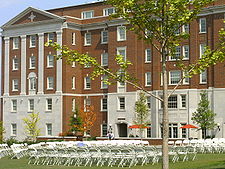
The Commons, located on the Peabody campus, is part of the new College Halls system at Vanderbilt.
In the late 1950s, the Vanderbilt Divinity School became a hotbed of the emerging civil rights movement, and the university expelled one of the movement's leaders, James Lawson. In 2005, Lawson was re-hired as a Distinguished University Professor for the 2006–07 academic year, and named a Distinguished Alumnus for his achievements.
The university drew national attention in 1966 when it recruited Perry Wallace, the first African American athlete in the Southeastern Conference. Wallace, from Nashville, played varsity basketball for Vanderbilt from 1967–1970, and faced considerable opposition from segregationists when playing at other SEC venues. In 2004, a student-led drive to retire Wallace's jersey finally succeeded. Harold Stirling Vanderbilt was chairman of the Board of Trust between 1955 and 1968 when racial integration was a prominent topic at the school. Today, a statue of him in front of Buttrick Hall memorializes his efforts.
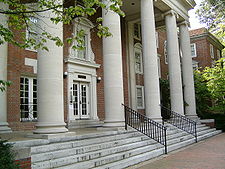
West House, part of The Commons at Vanderbilt, home to 112 freshmen
In 1966, the Oberlin Graduate School of Theology moved from Ohio to Nashville, and merged with the Vanderbilt Divinity School. In 1979, Vanderbilt absorbed its neighbor, Peabody College.
History, race, and civil rights issues came to the forefront on the campus in 2002, when the university decided to rename Confederate Memorial Hall, a residence hall on the Peabody campus as Memorial Hall. Nationwide attention resulted, in part due to a lawsuit by the Tennessee chapter of the United Daughters of the Confederacy, who had helped pay for the building's construction in 1933 with a $50,000 contribution.
The Davidson County Chancery Court dismissed the lawsuit in 2003, but the Tennessee Court of Appeals ruled in May 2005 that the university must pay damages based on the present value of the United Daughters of the Confederacy's contribution if the inscription bearing the name "Confederate Memorial Hall" was removed from the building or altered.
In late July 2005, the university announced that although it had officially renamed the building and all university publications and offices will refer to it solely as Memorial Hall, the university would neither appeal the matter further, nor remove the inscription and pay damages.
组织
Administration
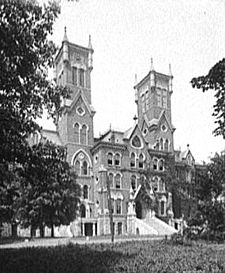
Old Main (1875), photographed before it burned in 1905
Vanderbilt University, as a private corporation, is wholly governed by an independent, self-perpetuating Board of Trust. The board comprises 45 regular members (plus any number of trustees emeriti) and the chancellor, the university's chief executive officer. Each trustee serves a five-year term (except for four recently-graduated undergraduates, who serve two two-year terms). Martha Rivers Ingram is the board's current chairman.
Nicholas S. Zeppos currently serves as chancellor of Vanderbilt University. He was appointed interim chancellor after the departure of Gordon Gee, who left to reassume the presidency of Ohio State University on August 1, 2007, and was named chancellor in his own right on March 1, 2008.
Gee had been appointed chancellor by the Board of Trust in February 2000. Controversy arose in 2006 over Gee's spending during his tenure at Vanderbilt, including the over $6 million spent on remodeling his university-owned house. An article in The Wall Street Journal in September of that year examining the spending of college and university executives used Gee and Vanderbilt as an example of the lax oversight common to higher education. The Board of Trust has since established a committee to monitor more closely the spending by the chancellor's office.
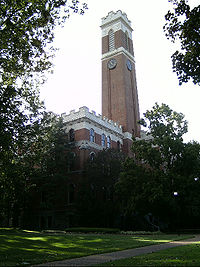
After the fire, Old Main was rebuilt with one tower and renamed Kirkland Hall. It is currently home to Vanderbilt's administration.
Since the opening of the university in 1875, only six other individuals have served as chancellor. Landon Garland was the university's first chancellor, serving from 1875 to 1893. Garland organized the university and hired its first faculty. Garland Hall, an academic building on campus, is named in his honor.
The next chancellor was James Kirkland—serving from 1893 to 1937, he had the longest tenure of any Vanderbilt chancellor. He was responsible for severing the university's ties with the Methodist Church and relocating the medical school to the main campus. Vanderbilt's Main Building was renamed Kirkland Hall after Kirkland left in 1937.
The longest-tenured chancellor was followed by one of the shortest-tenured. Oliver Carmichael served Vanderbilt for just nine years, 1937 to 1946. Carmichael developed the graduate school, and established the Joint University Libraries for Vanderbilt, Peabody, and Scarritt College. Carmichael Towers, a set of high-rise dormitories on the northern edge of campus, were named for Chancellor Carmichael.
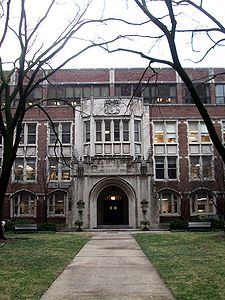
The entrance of Vanderbilt Medical School
Carmichael's successor was Harvie Branscomb. Branscomb presided over a period of major growth and improvement at the university that lasted from 1946 until 1963. He was responsible for opening the admissions policy to all races. Branscomb Quadrangle is a residence hall complex named for the chancellor.
Alexander Heard, for whom the campus's 10-library system (with 3.3 million total volumes) is named, served as chancellor from 1963 to 1982. During his 20-year tenure, the Owen Graduate School of Management was founded, and Vanderbilt's merger with Peabody College was negotiated. He also survived calls for his ouster because of his accommodating stance on desegregation.
Joe B. Wyatt was the chancellor who served immediately before Gee, from 1982 until 2000. Wyatt oversaw a great increase in the university's endowment, an increase in student diversity, and the renovation of many campus buildings. Wyatt placed great emphasis on improving the quality faculty and instruction, and during his tenure Vanderbilt rose to the top 25 in the U.S. News & World Report's annual rankings for the first time. The Wyatt Center on Peabody's campus is named for Wyatt and his wife.
Medical Center
The Vanderbilt University Medical Center is a vital component of the university and is the only Level I Trauma Center in Middle Tennessee. VUMC comprises the following units: Vanderbilt University Hospital, Monroe Carell, Jr., Children's Hospital at Vanderbilt, Vanderbilt-Ingram Cancer Center, Vanderbilt Psychiatric Hospital, Vanderbilt Clinic, Vanderbilt Bill Wilkerson Center, Vanderbilt Stallworth Rehabilitation Hospital, Vanderbilt Psychiatric Hospital, Eskind Biomedical Library, Vanderbilt Sports Medicine, Dayani Human Performance Center, Vanderbilt Page Campbell Heart Institute, Vanderbilt University School of Medicine, and Vanderbilt University School of Nursing.
With over 21,500 employees (including 2,876 full-time faculty), Vanderbilt is the largest private employer in Middle Tennessee and the second largest in the state (after FedEx, headquartered in Memphis). Approximately 74% of the university's faculty and staff are employed by the Medical Center. In 2008, the medical center was placed on the Honor Roll of U.S. News & World Report's annual rating of the nation's best hospitals for the third time, ranking 15th overall in the country, and 17 of the faculty were members of one of the National Academies. In 2004, the university reported that 24.1% of non-Medical Center faculty were women, while 14.4% were of a racial or ethnic minority.
Students and faculty
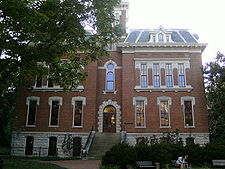
Benson Science Hall, one of the first campus buildings, houses the English and history departments.
Profile
As of December 2009, Vanderbilt had an enrollment of 6,794 undergraduate and 5,720 graduate and professional students. Students from all 50 states and more than 90 countries attend Vanderbilt, with 60% of the total student body coming from outside the Southeast; 8% of students are from outside the United States. Moreover, 24% of the undergraduate class of 2010 was non-Caucasian, while roughly half were women.
Vanderbilt offers undergraduates the chance to pursue 70 majors, or the chance to create their own, in its four undergraduate schools and colleges: the College of Arts and Science, the School of Engineering, Peabody College of Education and Human Development, and Blair School of Music. The university also has six graduate and professional schools, including the Divinity School, Graduate School, Law School, School of Medicine, School of Nursing, and Owen Graduate School of Management.
The university's undergraduate programs are highly selective: in 2010, the Office of Undergraduate Admissions accepted 16% of applicants. In its most recent annual comparison of admissions selectivity, The Princeton Review gave Vanderbilt a rating of 98 out of 99. The freshmen in the Class of 2013 had standardized test scores that were well above average: the interquartile range (25th percentile-75th percentile) of SAT scores was 1440-1540 under the old scale, while the interquartile range of ACT scores was 31-34.
Research
As with any large research institution, Vanderbilt investigators work in a broad range of disciplines, and the university was among the top 25 recipients of federal research dollars in 2006. In 2007, Vanderbilt University School of Medicine ranked 10th in terms of NIH funding ($282.3 million). Its Institute for Space and Defense Electronics, housed in the Department of Electrical Engineering and Computer Science, is the largest such academic facility in the world.
Among its more unusual activities, the university has institutes devoted to the study of coffee and of bridge. Indeed, the modern form of the latter was developed by Harold Stirling Vanderbilt, a former president of the university's Board of Trust and a great-grandson of the Commodore. In addition, in mid-2004 it was announced that Vanderbilt's chemical biology research may have serendipitously opened the door to the breeding of a blue rose, something that has long been coveted by horticulturalists and rose lovers.
Vanderbilt's research record is blemished, however, by a study university researchers, in conjunction with the Tennessee Department of Health, conducted on iron metabolism during pregnancy in the 1940s. Between 1945 and 1949, over 800 pregnant women were given radioactive iron. Standards of informed consent for research subjects were not rigorously enforced at that time, and many of the women were not informed of the potential risks. The injections were later suspected to have caused cancer in at least three of the children who were born to these mothers. In 1998, the university settled a class action lawsuit with the mothers and surviving children for $10.3 million.
Exploration is the university's online research magazine. It publishes multimedia stories that explain campus research projects ranging from archeology to zoology, probe the motives of the explorers that perform these studies, and describe the experiences of Vanderbilt students who become involved in scientific research. Vanderbilt undergraduates also publish a journal of original research. Vanderbilt is a member of the Oak Ridge Associated Universities and the Universities Space Research Association.
Rankings
|
|
University rankings (overall)
|
|
| ARWU World |
41 |
| ARWU North & Latin America |
34 |
| Forbes |
77 |
| Times Higher Education |
101 |
| USNWR National University |
17 |
| WM National University |
39 |
In its 2010 edition, U.S. News & World Report placed Vanderbilt at 17th, tied with Rice University and Emory University, in its ranking of national universities. Most notably, in the same publication's 2010 graduate program rankings, the Peabody College of Education was ranked first in the nation among schools of education. In addition, the Vanderbilt Law School was listed at 17th, the School of Medicine was listed at 15th among research-oriented medical schools, the School of Nursing was listed at 19th, the School of Engineering was listed at 39th, and the Owen Graduate School of Management was listed at 33rd among business schools. Additionally, Vanderbilt is ranked first in the nation in the fields of special education, audiology, and education administration.
In The Times Higher Education Supplement 2006, Vanderbilt is ranked 26th in North America and 53rd worldwide. The 2007 Faculty Scholarly Productivity Index, a measure of the scholarly output of the faculty of nearly 7,300 doctoral programs around the United States, ranked Vanderbilt 8th among large research universities, and 1st in the areas of comparative literature, educational leadership, pharmacology, Portuguese, Spanish, and special education. Vanderbilt English Department's MFA Program in Creative Writing was ranked 18th among the top 50 writing programs in the United States in 2010 by Poets and Writers.
The Wall Street Journal ranked Owen second among "smaller" business schools in 2004. In 2008, Owen was ranked #30 by BusinessWeek.
Fortune magazine ranked Vanderbilt among the top 100 places to work in the United States, the only university on their list.
Campus layout
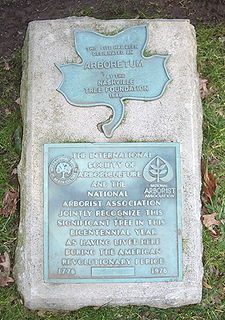
Vanderbilt's campus is a designated national arboretum.
The Vanderbilt campus is located approximately 1.5 miles (2.4 km) southwest of downtown in the West End neighborhood of midtown Nashville. It has an area of 330 acres (1.3 km), though this figure includes large tracts of sparsely used land in the southwest part of the main campus, as well as the Medical Center. The historical core of campus encompasses approximately 30 acres (0.1 km). The Vanderbilt campus is roughly fan-shaped (with the point at the corner of West End and 21st Avenues) and reflects the university's gradual expansion to the south and to the west. The campus is fairly compact, however, and the farthest distance on campus takes about 25 minutes to walk.
The oldest part of the Vanderbilt campus is known for its abundance of trees and green space, which stand in contrast to the surrounding cityscape of urban Nashville. The campus was designated as a national arboretum in 1988 by the Association of Botanical Gardens and Arboreta, and over 300 species of trees and shrubs can be found on campus, including one of every species of tree that is indigenous to the state of Tennessee. One tree, the Bicentennial Oak between Rand Hall and Garland Hall, is certified to have lived during the American Revolution and is the oldest living thing on the campus.
Main campus
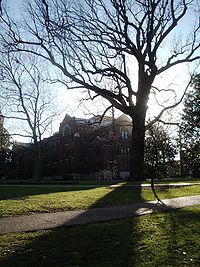
Bicentennial Oak, facing Buttrick Hall, predates the Revolutionary War.
In the northeast corner of the campus (the base of the fan) is the original campus. The first college buildings, including Kirkland Hall, were erected here in the 1870s, 1880s, and 1890s. This section stretches from West End Avenue south to the Stevenson Center and west from 21st Avenue to Alumni Lawn. The majority of the buildings of the arts and humanities departments of the College of Arts and Science, as well as the facilities of the Law School, Owen Graduate School of Management, and the Divinity School, are located in the original campus. Additionally, the Heard Central Library and Sarratt Student Center/Rand Hall can be found on the original campus.
Flanking the original campus to the south are the Stevenson Center for Science and Mathematics and the School of Engineering complex (Jacobs Hall-Featheringill Hall). Housing the Science Library, the School of Engineering, and all the science and math departments of the College of Arts and Science, this complex sits between the original campus and the Medical Center. The Vanderbilt University Medical Center itself takes up the southeastern part of the campus. Besides the various associated hospitals and clinics and the facilities of the Schools of Medicine and Nursing, the medical center also houses many major research facilities.
West of the original campus and the Medical Center, Greek Row and the bulk of the Vanderbilt residence halls are found. From north to south, Carmichael Towers, Greek Row, Branscomb Quadrangle, and Highland Quadrangle house the vast majority of on-campus residents in facilities ranging from the double-occupancy shared-bathroom dorms in Branscomb and Towers to the apartments and lodges in Highland Quadrangle. This part of campus is newer than the others; Vanderbilt's westward growth did not start until the 1950s. This portion of campus was built by tearing down small single family houses and duplexes dating from the early 20 century, and so the area has significantly less green space than the arboretum on the original campus and is more indicative of the university's urban locale.
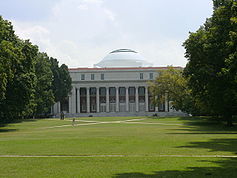
The Wyatt Center on Vanderbilt's Peabody campus
Memorial Gymnasium, Vanderbilt Stadium, Hawkins Field, McGugin Center, and all the other varsity athletic fields and facilities are to be found in the extreme west of campus. The Student Recreation Center and its associated intramural fields are located south of the varsity facilities.
Peabody campus
Directly across 21st Avenue from the Medical Center sits the campus of the Peabody College of Education and Human Development. Due to their separate histories until the merger, the Peabody campus was configured in a radically different style than the original Vanderbilt campus. Whereas the latter has an unplanned organic design with buildings scattered throughout, Peabody campus was planned as a geometric design, similar to the Jeffersonian style of the University of Virginia. The campus is home not only to Peabody College but also to The Commons, where all freshmen live together as part of the College Halls plan.
Student life
Organizations
The university recognizes nearly 400 student organizations, ranging from academic major societies and honoraries to recreational sports clubs, the oldest of which is the Vanderbilt Sailing Club. There are also more than 30 service organizations on campus, giving students the opportunity to perform community service across the country and around the world, including the Vanderbilt-founded Alternative Spring Break.
Despite the lack of an organized journalism curriculum, no less than ten editorially-independent media outlets are produced and controlled by students. In addition, a sportswriting scholarship, named for Vanderbilt alumni Fred Russell and Grantland Rice, is awarded each year to an entering Vanderbilt freshman who intends to pursue a career in sportswriting. Vanderbilt Student Communications, Inc., (VSC) owns eight print publications, a broadcast radio station, and a closed-circuit television station. One publication, The Vanderbilt Hustler, was established in 1888 and is the oldest continuously published newspaper in Nashville (the newspaper's name references another nickname for the Commodore based on his cutthroat business practices, i.e., that he "hustled" people out of their money). The on-campus radio station, WRVU, represents the student body by playing a range of music from bluegrass to choral, with a focus on non-mainstream music, while the campus television station, Vanderbilt Television (VTV), showcases student-produced films, skits, and news and entertainment-based shows.
VSC was formed as a not-for-profit corporation in 1967 to insulate the university from potential liability and to maintain journalistic independence after a series of controversial articles published by The Hustler. During the 1970s, VSC funded a visiting journalist position to provide advice and counsel to its various operating units. Initially, the directors of VSC included a faculty chairman of the board of directors, several student directors, and an outside journalist director. Among the earlier journalist directors was John Seigenthaler, the then-president, publisher, and editor of The Tennessean, who also played an instrumental role in the creation of USA Today.
Additional student publications include those published by the Vanderbilt University Law School, which publishes three law reviews; the flagship journal is the Vanderbilt Law Review.
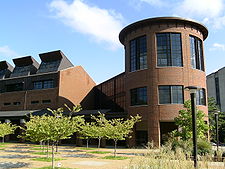
The E. Bronson Ingram Studio Art Center, located in the heart of the central campus, near Branscomb Quadrangle, was completed in 2005.
Greeks are an active part of the social scene on and off campus, and the university is home to 21 fraternities and 14 sororities. As of 2006–2007, 35% of men were members of fraternities and 49% of women were members of sororities, or 42% of the total undergraduate population.
Honor Code
Since the first classes began at Vanderbilt, the Honor System has served to strengthen the academic integrity of the university. Its principles were outlined in a famous quote by long-time Dean of Students Madison Sarratt:
Today I am going to give you two examinations, one in trigonometry and one in honesty. I hope you will pass them both, but if you must fail one, let it be trigonometry, for there are many good men in this world today who cannot pass an examination in trigonometry, but there are no good men in the world who cannot pass an examination in honesty.
As a part of their first act together as a class, each Vanderbilt class meets together at the Honor Code Signing Ceremony, where every member of the class pledges their honor and signs the code. The signature pages are then hung in Sarratt Student Center. The ceremony is one of only two occasions where a class will be congregated in a single place at the same time (the other being Commencement).
The Undergraduate Honor Council was formed to help enforce and protect the tradition of the Honor Code. Today, the Honor Council serves two simultaneous aims: to enforce and protect the Honor Code and to inform members of the Vanderbilt community about the Honor System.
Student housing
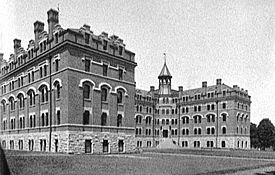
Kissam Hall was a men's dormitory from 1901 until it was razed in 1958. The baths were all in the basement.
All undergraduate students not living with relatives in Davidson County are required to live on campus all four years to the extent that on-campus student housing facilities can accommodate them. In practice, though, approximately 83% of undergraduates—freshmen, sophomores, nearly all juniors and most seniors—currently live on campus. The remaining undergraduates join graduate and professional students in living off-campus. Student life at Vanderbilt is consequently heavily intertwined with campus life.
However, the on-campus residential system is currently undergoing a radical change. The new system, announced by the administration in 2002, would change the current structure of quadrangle-based residence halls to a new system of residential colleges, to be called "College Halls". Similar to the residential structures at Caltech, Harvard, Rice, and Yale, the new College Halls system would create residence halls where students and faculty would live together in a self-contained environment, complete with study rooms, cafeterias, laundry facilities, and stores. This project is now underway and is scheduled to be completed within the next 20 years.
The first step in the College Halls system will be The Commons, a collection of ten residential halls on the Peabody campus that will house all first-year students beginning in the fall of 2008. While the university currently houses freshmen in three separate and distinct residential areas, it is hoped that The Commons will give first-year students a unified (and unifying) living-learning experience. Vanderbilt renovated five existing residence halls on Peabody and built five new halls to complement them. Two of the new residence halls have received LEED silver certification and the new Commons Dining Center has received gold certification, making Vanderbilt the only university in the state to be recognized by the U.S. Green Building Council. The university expects all five of the new residence halls and one renovated residence hall to eventually receive LEED recognition. The total cost of The Commons construction project is expected to be over $150 million.
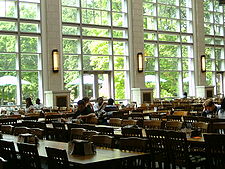
The Commons Center dining hall
With the addition of these new residence halls, the university will be able to house all undergraduate students on campus. Since university policy requires undergraduates to live on campus when possible, Vanderbilt's Office of Housing and Residential Education will no longer grant students permission to live off campus, beginning with the class graduating in 2009. Many current students who came to Vanderbilt with the understanding that seniors were generally allowed to live off campus are now disappointed that they must live on campus all four years. However, university administrators believe the undergraduate community receives the greatest benefit from living in on-campus residence halls, citing increased interaction with faculty, better academic performance, and stronger interpersonal relationships.
Plans are under way to build the next two College Halls at the corner of West End Avenue and 21st Avenue, the current site of Kissam Quadrangle. Upperclassman students will live in a mixture of single- and double-occupancy rooms organized into suites. A dining center will be located between the two College Halls with rooftop and patio seating. Guest quarters, classroom space, conference rooms, offices and underground parking are all also planned for the yet-unnamed facility. Everton Oglesby Architects PLLC has been selected to design the two new College Halls.
体育运动
Main article: Vanderbilt Commodores
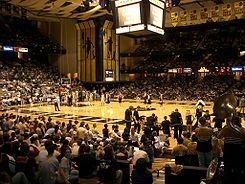
Vanderbilt's basketball teams play in Memorial Gymnasium
Vanderbilt is a charter member of the Southeastern Conference and is the conference's only private school. The university fields six men's and nine women's intercollegiate teams. With fewer than 6,600 undergraduates, the school is also the smallest in the conference; the SEC's next-smallest school, the University of Mississippi, has nearly twice as many undergraduate students. Additionally, the school is a member of the American Lacrosse Conference for women's lacrosse, as the SEC does not sponsor that sport. Conversely, Vanderbilt is the only league school not to field teams in softball and volleyball, but has discussed adding either or both sports in the future.
Men's and women's tennis and men's and women's basketball are traditionally Vanderbilt's strongest sports. Both teams play in quirky Memorial Gym, built in 1952. Memorial Gym is noted for the location of the team benches on the baselines, the four separate sections of stands on the four sides of the court, the distance of the stands from the court and the elevation of the court above the first few rows of seats on each sideline. The more recently founded women's lacrosse and bowling programs as well as the long-standing men's baseball program are also experiencing moderate national success. After enjoying success in the first half of the 20th century, the football program has generally struggled in more recent times. However, the 2008 Commodore football team finished with its first winning season in over 25 years and with its first postseason win in over 50 years.
Athletics restructuring
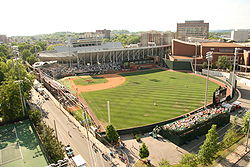
Hawkins Field in June 2007
In September 2003, Vanderbilt earned national attention when it announced that it was eliminating its athletic department. Then-Chancellor Gee called Vanderbilt's varsity athletes "isolated", and insisted that student-athletes would perform better if they were integrated into the rest of the student body. So rather than administer athletics separately from student life, Gee folded the university's varsity teams into the Office of Student Life, the same group that oversees all student organizations. The university is unique in Division I in this regard. Despite fears that Vanderbilt would lose coaches and recruits or would be forced out of the SEC, the university has experienced considerable success since the change; 2006–07 was one of the best in the school's athletic history. At one point, seven of Vanderbilt's 16 teams were concurrently ranked in the Top 25 of their respective sports. Women's bowling won the NCAA championship, bringing the university its first and only team championship since the advent of the NCAA. The baseball team qualified for the NCAA Super Regionals in 2004, had the nation's top recruiting class in 2005 according to Baseball America, made the NCAA field again in 2006, and won the 2007 SEC regular-season and tournament championships. Vanderbilt was ranked first in most polls for a large portion of the 2007 season, and the team secured the top seed in the 2007 NCAA tournament.
Mascot
Vanderbilt's intercollegiate athletics teams are nicknamed the Commodores, in honor of the nickname given to Cornelius Vanderbilt, who made his fortune in shipping. Students and alumni refer to Vanderbilt athletic teams as the "Dores" and use the cheer "Go Dores!"
The term commodore was used by the Navy during the mid- to late 19th century. A commodore was the commanding officer of a task force of ships, and therefore higher in rank than a captain but lower in rank than an admiral. The rank is still used by the British Royal Navy and other Commonwealth countries, but the equivalent modern-day rank in the U.S. Navy is rear admiral lower-half. Since the term was used most during the 19th century, Vanderbilt's mascot, "Mr. C", is usually portrayed as a naval officer from the late 1800s, complete with mutton chops, cutlass, and uniform.
[edit] Notable faculty and alumni
Main article: List of Vanderbilt University people
Vanderbilt has approximately 114,000 living alumni, with 31 alumni clubs established worldwide. Many Vanderbilt alumni have gone on to make significant contributions in politics, in the arts, and in the sciences. Lamar Alexander (B.A. 1962) is a former Governor of Tennessee and a current U.S. senator; he filled the seat left vacant by the retirement of Fred Thompson (J.D. 1971). Two U.S. vice presidents, John Nance Garner and Al Gore, attended the university, but did not graduate. However, Gore's wife, Tipper, is herself an alumna, receiving a master's degree from Peabody in 1975. Other alumni who are or have been involved in politics include former United States Supreme Court Associate Justice James Clark McReynolds (B.S. 1882); Congressmen Steve Cohen (B.A. 1971) and Ric Keller (J.D. 1992); David Boaz (B.A. 1975), Executive Vice President of the Cato Institute; and John R. Steelman (M.A. 1924), former White House Chief of 工作人员. In addition, Senator Theodore Bilbo attended both Peabody College and the Law School. Bill Frist, a cardiothoracic surgeon and former U.S. Senate Majority Leader, is a faculty member at Vanderbilt University Medical Center.
Given the university's location in Nashville, it is not surprising that many of its alumni become involved in the music industry. Dinah Shore (B.A. 1938), Rosanne Cash (B.A. 1979), Amy Grant (B.A. 1982), and Dierks Bentley (B.A. 1997) are all alumni. Shore later went on to star in a variety of films; other Vanderbilt alumni with Hollywood connections include Academy Award-winners Delbert Mann (B.A. 1941) and Tom Schulman (B.A. 1972) and actors Molly Sims (B.S. 1995) and Joe Bob Briggs (B.A. 1974).
In addition, the university has a rich literary and journalistic legacy. Most notably, the Southern Agrarians were a group of influential American writers and poets in the 1920s and 1930s based at Vanderbilt. Three U.S. Poets Laureate are Vanderbilt alums: Allen Tate (B.A. 1922), Robert Penn Warren (B.A. 1925), and Randall Jarrell (M.A. 1938). Warren later went on to the win the Pulitzer Prize. Novelists James Dickey (B.A. 1949) and James Patterson (M.A. 1970) also graduated from Vanderbilt. Famed ethics philosopher, Alasdair MacIntyre, author of After Virtue, taught there in 1982 and 1985. Bestselling economics writer Ravi Batra, author of The Downfall of Capitalism and Communism, taught there in 1981. Two well-known sportswriters, Grantland Rice (B.A. 1901) and Fred Russell (B.A. 1927), have a scholarship named after them at the university, and Buster Olney (B.A. 1988) writes for ESPN.com and The New York Times. Journalist David Brinkley attended briefly. Skip Bayless (B.A. 1974) of ESPN First Take attended Vanderbilt as a recipient of the Russell-Rice scholarship. Willie Geist (B.A. 1997) is a host of MSNBC's Morning Joe.
Current Chicago Bears quarterback Jay Cutler (B.S. 2005) is also a Vanderbilt alum and was drafted in the first round of the 2006 NFL Draft by the Denver Broncos. Offensive tackle Chris Williams (B.S. 2008) was a first round pick by the Chicago Bears in 2008. Vanderbilt also produced the first overall draft pick of Major League Baseball in 2007 with David Price and the second overall draft pick of Major League Baseball in 2008 with Pedro Alvarez. Price and Alvarez were drafted by the then-named Tampa Bay Devil Rays and the Pittsburgh Pirates, respectively. ESPN basketball analyst Carolyn Peck was a standout member of the Commodores' basketball program from 1985–1988, eventually becoming a head coach and leading the Purdue Boilermakers women's basketball team to a national championship in 1999.
Three alumni, biochemist Stanford Moore (B.A. 1935), economist and microcredit pioneer Muhammad Yunus (Ph.D. 1971), and former Vice President Al Gore have won the Nobel Prize. Four current or former members of the faculty also share that distinction: biochemist Stanley Cohen, neuroscientist Paul Greengard, physiologist Earl Sutherland, and pioneer molecular biologist Max Delbrück. Yunus was also a recipient of the Presidential Medal of Freedom in 2009.
更多
 |
Wikimedia Commons has media related to: Vanderbilt University |
- 拉丁语 American Public Opinion Project
- Southern Ivy
Notes
As of December 31, 2008.
See article on the Declaration of Helsinki.
参考文献
- ^ Patterson, Jim (2009-09-24). "Vanderbilt Announces Fiscal 2009 Results". Vanderbilt University: myVU. http://sitemason.vanderbilt.edu/news/releases/2009/09/24/vanderbilt-announces-fiscal-2009-results.92154. Retrieved 2009-10-01.
- ^ http://www.vanderbilt.edu/info/facts/
- ^ http://www.vanderbilt.edu/info/facts/#financial
- ^ http://www.rhodesscholar.org/stats/institution/1862
- ^ http://admissions.vanderbilt.edu/undergraduate-alumni.php
- ^ http://www.nsf.gov/od/nms/results.cfm
- ^ "The History of Vanderbilt". Vanderbilt University. http://www.vanderbilt.edu/history.html. Retrieved 2007-05-24.
- ^ Gulley, Frank. "Vanderbilt University and Southern Methodism". http://pages.prodigy.net/nhn.slate/nh00073.html. Retrieved 2008-02-20.
- ^ Patterson, Jim (2006-01-30). "The Rev James Lawson to return as visiting professor". The Vanderbilt Register. http://www.vanderbilt.edu/register/articles?id=24339. Retrieved 2007-01-10.
- ^ "Perry Wallace". Tennessee Sports Hall of Fame. 2003. http://www.tshf.net/inductees/2003Wallace.htm. Retrieved 2007-08-17.
- ^ Vanderbilt University (2002-09-19). "Confederate Memorial Hall renamed Memorial Hall". The Vanderbilt Register. http://www.vanderbilt.edu/register/articles?id=3316. Retrieved 2007-05-24.
- ^ Latt, Elizabeth P (2003-10-01). "Court ruling supports Vanderbilt decision to change name of building". The Vanderbilt Register. http://www.vanderbilt.edu/register/articles?id=6663. Retrieved 2007-05-24.
- ^ Vanderbilt University (2005-05-05). "Appeals court rules on Memorial Hall dispute". The Vanderbilt Register. http://www.vanderbilt.edu/register/articles?id=19550. Retrieved 2007-05-24.
- ^ Vanderbilt University (2005-07-25). "Vanderbilt drops suit over Memorial Hall". The Vanderbilt Register. http://www.vanderbilt.edu/register/articles?id=20856. Retrieved 2007-05-24.
- ^ "Membership and Procedures of the Board of Trust". Vanderbilt University. November 21, 2008. http://www.vanderbilt.edu/boardoftrust/bylaws/mandp.html. Retrieved January 7, 2009.
- ^ Loos, Ralph (2007-07-11). "Gee to leave Vanderbilt for Ohio State". The Tennessean. http://www.tennessean.com/apps/pbcs.dll/article?AID=/20070711/NEWS04/70711037. Retrieved 2007-07-11.
- ^ Middlebrooks, Elizabeth (2008-03-01). "No longer 'iChancellor,' Zeppos confirmed to permanent position". The Vanderbilt Hustler. http://www.insidevandy.com/drupal/node/6856. Retrieved 2008-03-01.
- ^ Duncan, Walker (2006-09-26). "WSJ: Vandy Making Sure Gee isn't Puffing Away Millions". The Nashville Post. http://www.nashvillepost.com/news/2006/9/26/iwsji_takes_a_hard_look_at_vanderbilt_chancellor_gordon_gees_spending_habits. Retrieved 2007-01-10.
- ^ Office of the Chancellor. "History of the Office". Vanderbilt University. http://www.vanderbilt.edu/chancellor/history.html. Retrieved 2007-01-10.
- ^ "Joe B. Wyatt 1982-2000". Vanderbilt University. http://www.vanderbilt.edu/chancellorsearch/wyatt.html. Retrieved 2008-12-13.
- ^ Vanderbilt University News Service (January 2008). "RE:VU: Quick Facts about Vanderbilt". Vanderbilt University. http://www.vanderbilt.edu/facts.html. Retrieved 2008-01-10.
- ^ "Vanderbilt University Medical Center, Visitors". Vanderbilt University. http://www.mc.vanderbilt.edu/root/visitors.html. Retrieved 2007-07-02.
- ^ Office of Undergraduate Admissions. "Students". Vanderbilt University. http://www.vanderbilt.edu/Admissions/fastFacts.php#学生. Retrieved 2007-07-01.
- ^ Office of Undergraduate Admissions. "Class of 2010". Vanderbilt University. http://www.vanderbilt.edu/admissions/fastFacts.php#Profile. Retrieved 2007-05-28.
- ^ The Princeton Review. "Vanderbilt University: General Info". The Princeton Review 2006. http://www.princetonreview.com/college/research/profiles/generalinfomore.asp?listing=1022817<id=1. Retrieved 2007-04-25.
- ^ Salisbury, David F (2007-02-05). "VU gains ground in competition for federal research dollars". The Vanderbilt Register. http://www.vanderbilt.edu/register/articles?id=31832. Retrieved 2007-07-01.
- ^ Harrison, David (2004-05-23). "A true scientific breakthrough: the blue rose". The Daily Telegraph. http://www.telegraph.co.uk/news/main.jhtml?xml=/news/2004/05/23/nrose23.xml. Retrieved 2007-07-03.
- ^ "$10 Million Settlement In Radiation Suit". The New York Times. 1998-05-29. http://query.nytimes.com/gst/fullpage.html?res=9801EEDD1138F93AA15756C0A96E958260&n=Top%2fReference%2fTimes%20Topics%2fOrganizations%2fV%2fVanderbilt%20University. Retrieved 2007-09-20.
- ^ Schneider, Keith (1994-03-02). "Scientists Share in Pain Of Experiment Debates". The New York Times. http://query.nytimes.com/gst/fullpage.html?res=9903E0D8153AF931A35750C0A962958260&sec=health&spon=&pagewanted=1. Retrieved 2007-07-05.
- ^ "Vanderbilt University Radiation Class Action". Lieff Cabraser Heimann and Bernstein, LLP. 1998-07-27. http://www.lieffcabraser.com/vanderbilt.htm. Retrieved 2007-01-10.
- ^ Shanghai Jiao Tong University (2009). "Academic Ranking of World Universities". Institute of Higher Education, Shanghai Jiao Tong University. http://www.arwu.org/ARWU2009.jsp. Retrieved 2009-12-23.
- ^ Shanghai Jiao Tong University (2009). "Ranking of North & Latin American Universities". Institute of Higher Education, Shanghai Jiao Tong University. http://www.arwu.org/Americas2009.jsp. Retrieved 2009-12-23.
- ^ "America's Best Colleges". Forbes. 2009. http://www.forbes.com/lists/2009/94/colleges-09_Americas-Best-Colleges_Rank.html. Retrieved 2009-09-13.
- ^ The Times (2009). "World University Rankings". The Times Higher Educational Supplement. http://www.topuniversities.com/university-rankings/world-university-rankings/2009/results. Retrieved 2010-02-09.
- ^ "National Universities Rankings". America's Best Colleges 2009. U.S. News & World Report. 2009. http://colleges.usnews.rankingsandreviews.com/college/national-search. Retrieved 2009-05-18.
- ^ "The Washington Monthly National University Rankings" (PDF). The Washington Monthly. 2009. http://www.washingtonmonthly.com/college_guide/rankings/national_university_rank.php. Retrieved 2009-12-23.
- ^ "National Universities: Top Schools". America's Best Colleges 2010. U.S. News & World Report. http://colleges.usnews.rankingsandreviews.com/college/national-search. Retrieved 2008-08-22.
- ^ "Graduate Schools: Index". America's Best Graduate Schools 2008. U.S. News & World Report. http://www.usnews.com/usnews/edu/grad/rankings/rankindex_brief.php. Retrieved 2007-04-25.
- ^ "Education: Special Education". America's Best Graduate Schools 2008. U.S. News & World Report. http://www.usnews.com/usnews/edu/grad/rankings/edu/brief/edusp07_brief.php. Retrieved 2007-04-25.
- ^ Boerner, Craig (2007-03-30). "National rankings laud Medical, Nursing schools". The Reporter. http://www.mc.vanderbilt.edu/reporter/index.html?ID=5442. Retrieved 2007-04-25.
- ^ "Education: Education administration and supervision". America's Best Graduate Schools 2010. U.S. News & World Report. http://grad-schools.usnews.rankingsandreviews.com/best-graduate-schools/top-education-schools/education-administration. Retrieved 2009-04-23.
- ^ O'Leary, John, ed (2006-10-06). "World University Rankings 2006" (Adobe PDF). The Times Higher Education Supplement: p. 3. http://www.fc.ethz.ch/facts/inst_research/thes/THES_World_University_Rankings_2006.pdf. Retrieved 2007-01-10.
- ^ Fogg, Piper (2007-01-12). "A New Standard for Measuring Doctoral Programs". The Chronicle of Higher Education: p. A8. http://chronicle.com/weekly/v53/i19/19a00801.htm. Retrieved 2007-01-10.
- ^ cite http://www.pw.org/content/top_fifty_mfa_programs_united_states_comprehensive_guide
- ^ Vanderbilt University (2004-09-22). "Owen School ranked No. 2 among smaller schools by Wall Street Journal". Press release. http://www.vanderbilt.edu/news/releases/2004/9/22/owen_school_ranked_no._2_among_smaller_schools_by_wall_street_journal. Retrieved 2007-04-25.
- ^ "The Best U.S. Business Schools". BusinessWeek. http://images.businessweek.com/ss/08/11/1112_best_business_schools/31.htm. Retrieved 2008-11-17.
- ^ Levering, Robert; Moskowitz, Milton (February 2, 2009). "100 Best Companies To Work For". Fortune 159 (2): 78.
- ^ Vanderbilt University Office of Facilities Information Services. Vanderbilt University Campus Map [map], January 2006 edition. Section Overleaf. Retrieved on 2007-10-10.
- ^ Taylor, Kelly; Sam Patton (2007-04-04). "Letter: Greer column fails to mention diversity of campus radio station". The Vanderbilt Hustler. http://www.insidevandy.com/drupal/node/3976. Retrieved 2007-04-26.
- ^ "2006 - 2007 Membership Statistics" (Microsoft Word Document). Vanderbilt University Office of Greek Life. http://www.vanderbilt.edu/greek_life/stats/statistics07spring.doc. Retrieved 2008-04-11.
- ^ Sarratt, Madison. "Honor Quotes". Vanderbilt University Undergraduate Honor Council. http://www.vanderbilt.edu/HonorCouncil/honorquo.php. Retrieved 2007-04-25.
- ^ Vanderbilt University (2007-08-17). "Vanderbilt first university in Tennessee recognized for "green" building". Press release. http://sitemason.vanderbilt.edu/newspub/bjfTyg?id=36730. Retrieved 2007-09-02.
- ^ Vanderbilt University (2008-06-18). "Vanderbilt University goes for the gold and wins for 'green' building efforts". Press release. http://www.vanderbilt.edu/myvu/news/2008/06/16/vanderbilt-university-goes-for-the-gold-and-wins-for-green-building-efforts.60447. Retrieved 2008-06-18.
- ^ Sisk, Chas (2007-09-03). "Seven Vanderbilt buildings to get 'green' certification". The Tennessean. http://www.tennessean.com/apps/pbcs.dll/article?AID=/20070903/BUSINESS02/709030330/1045/NEWS05. Retrieved 2007-09-03.
- ^ Lewis, Princine (2005-06-13). "Living and learning at Vanderbilt to undergo major transformation". The Vanderbilt Register. http://www.vanderbilt.edu/register/articles?id=31832. Retrieved 2007-07-01.
- ^ Brown, Christine (2007-01-21). "Class of 2009 will not live off campus". The Vanderbilt Hustler. http://www.insidevandy.com/drupal/node/2543. Retrieved 2007-04-25.
- ^ Levine, Jason (2007-03-18). "Administrators should work with students to resolve housing problems". The Vanderbilt Hustler. http://www.insidevandy.com/drupal/node/3627. Retrieved 2007-04-25.
- ^ Brashar, Joan (2008-07-31). "The Commons: What Comes Next?". Vanderbilt View. http://sitemason.vanderbilt.edu/vanderbiltview/articles/2008/07/31/the-commons-what-comes-next.61983. Retrieved 2008-08-03.
- ^ "Sports". Vanderbilt University Athletics. http://vucommodores.cstv.com/ot/nav-sports.html. Retrieved 2009-05-20.
- ^ "College Navigator - Varsity Athletic Teams". National Center for Education Statistics, U.S. Department of Education. http://nces.ed.gov/collegenavigator/?q=vanderbilt&s=all&id=221999. Retrieved 2009-05-20.
- ^ Patton, Maurice (2007-05-14). "Success may add teams at Vandy". The Tennessean. http://tennessean.com/apps/pbcs.dll/article?AID=/20070514/SPORTS0602/705140359/1002/SPORTS&template=pdaart. Retrieved 2007-05-24.
- ^ Bechtel, Mark (2007-06-06). "A Process of Elimination: Vanderbilt has found greater sports success since losing its athletics department". Sports Illustrated.
- ^ Vanderbilt University (2007-02-23). "Seven Vanderbilt teams ranked in Top 25". Press release. http://www.vanderbilt.edu/news/releases/2007/2/23/seven-vanderbilt-teams-ranked-in-top-25. Retrieved 2007-05-24.
- ^ Vanderbilt Athletic Department. "Vanderbilt Bowlers Make History". Vanderbilt University. http://vucommodores.cstv.com/sports/w-bowl/recaps/041407aab.html. Retrieved 2007-04-14.
- ^ Kimmey, Will (2005-10-11). "Vandy Recruits Stay For Top Recruiting Class". Baseball America. http://www.baseballamerica.com/today/college/051011vandy.html. Retrieved 2007-01-10.
- ^ Vanderbilt University (2007-05-28). "Vanderbilt Awarded No. 1 National Seed". Press release. http://vucommodores.cstv.com/sports/m-basebl/spec-rel/052807aae.html. Retrieved 2007-05-29.
- ^ Office of Undergraduate Admissions. "Notable Alumni: Politics/Government". Vanderbilt University. http://www.vanderbilt.edu/Admissions/randomAlumniPol.php. Retrieved 2007-05-24.
- ^ Patenaude, Lionel V (2002-03-08). "Garner, John Nance". The Handbook of Texas Online. Texas State Historical Association. http://www.tshaonline.org/handbook/online/articles/GG/fga24.html. Retrieved 2007-04-05.
- ^ Gore, Al. "Al's Bio". http://www.algore.com/bio.html. Retrieved 2007-05-24.
- ^ The Executive Office of the President. "White House Biography". U.S. National Archives and Records Administration. http://clinton4.nara.gov/WH/EOP/VP_Wife/megbio.html. Retrieved 2007-05-24.
- ^ Cohen, Steve. "Biography of Congressman Steve Cohen". U.S. Congress. http://cohen.house.gov/index.php?option=com_content&task=view&id=76&Itemid=4. Retrieved 2007-05-24.
- ^ Keller, Ric. "Biography". U.S. Congress. http://bioguide.congress.gov/scripts/biodisplay.pl?index=K000361. Retrieved 2008-10-05.
- ^ Presidential Scholars Foundation. "Presidential Scholars 1971". The Commission on Presidential Scholars. http://www.presidentialscholars.org/scholars_year.asp?scholar_year=1971. Retrieved 2007-04-05.
- ^ Office of Undergraduate Admissions. "Notable Alumni: Arts & Entertainment". Vanderbilt University. http://www.vanderbilt.edu/Admissions/randomAlumniArt.php. Retrieved 2007-05-24.
- ^ Office of Undergraduate Admissions. "Notable Alumni: Media". Vanderbilt University. http://www.vanderbilt.edu/Admissions/randomAlumniMedia.php. Retrieved 2007-05-24.
- ^ Office of Undergraduate Admissions. "Merit-based Aid". Vanderbilt University. http://www.vanderbilt.edu/Admissions/financeMeritAid.php. Retrieved 2007-05-24.
- ^ Severo, Richard (2003-06-12). "David Brinkley, Elder Statesman of TV News, Dies at 82". The New York Times. http://www.nytimes.com/2003/06/12/obituaries/12CND-BRINK.html?pagewanted=1&ei=5007&en=cff03291e81a5ba9&ex=1370836800&partner=USERLAND. Retrieved 2007-04-05.
- ^ Office of Undergraduate Admissions. "Notable Alumni: Science/Medicine". Vanderbilt University. http://www.vanderbilt.edu/Admissions/randomAlumniSci.php. Retrieved 2007-05-24.
- ^ Office of Undergraduate Admissions. "Notable Alumni: Philanthropy/Social Activism". Vanderbilt University. http://www.vanderbilt.edu/Admissions/randomAlumniPhi.php. Retrieved 2007-05-24.
External links
| Gymnasium, Vanderbilt University |
| U.S. National Register of Historic Places |
| Location: |
West End and 23rd Aves.
Nashville, Tennessee |
| Architect: |
Peter J. Williamson |
| Governing body: |
Vanderbilt University |
| Added to NRHP: |
February 23, 1972 |
| NRHP Reference#: |
72001233 |
| Mechanical Engineering Hall, Vanderbilt University |
| U.S. National Register of Historic Places |
| Location: |
Grand and 21st Aves.
Nashville, Tennessee |
| Architect: |
W. C. Smith |
| Governing body: |
Vanderbilt University |
| Added to NRHP: |
December 13, 1978 |
| NRHP Reference#: |
78002582 |
- Official website
- Official Athletics website
- Panoramic photograph of Vanderbilt published in 1909
- Arboreal tour of campus



